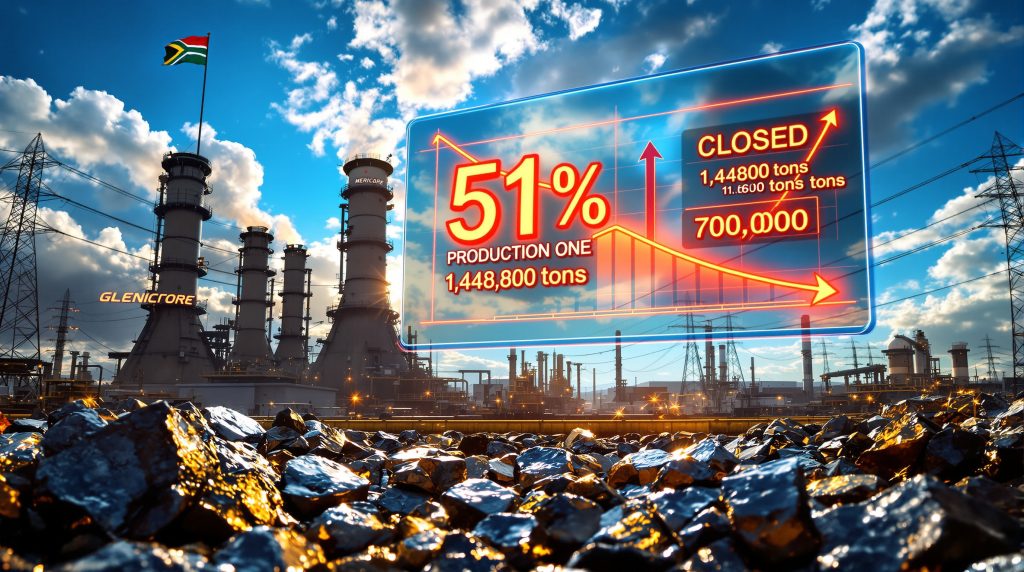Understanding South Africa's Ferrochrome Crisis
The Glencore-Merafe Chrome Venture has witnessed one of the most dramatic production collapses in South Africa's mining history. During the first nine months of 2025, the joint venture's Glencore-Merafe ferrochrome output slump reached catastrophic proportions, with production plummeting by 51% compared to the same period in 2024.
This unprecedented decline represents far more than simple operational challenges. The crisis reflects fundamental structural problems plaguing South Africa's energy-intensive mining sector, where rising electricity costs have rendered traditional smelting operations economically unviable. Furthermore, the energy transition challenges facing resource-dependent economies are becoming increasingly evident.
The Scale of Production Devastation
The numbers paint a stark picture of industrial collapse. Total ferrochrome production for the nine-month period dropped to just 709,000 tons, compared to 1,448,000 tons in 2024. For Merafe Resources, which holds a 20% stake in the venture, attributable production fell from 230,000 tons to merely 112,000 tons.
| Production Metric | 2024 (9 months) | 2025 (9 months) | Decline |
|---|---|---|---|
| Total Venture Output | 1,448,000 tons | 709,000 tons | -51% |
| Merafe's Share | 230,000 tons | 112,000 tons | -51% |
| Chrome Ore Mining | 732,000 tons | 710,000 tons | -3% |
The relatively modest 3% decline in chrome ore production demonstrates that the crisis stems not from geological constraints but from processing limitations. Consequently, mines continue operating while smelters remain shuttered, highlighting the energy cost burden that has made ferrochrome production financially unsustainable.
Energy Cost Crisis Driving Shutdowns
South Africa's state-owned power utility Eskom has implemented above-inflation electricity tariff increases that have fundamentally altered the economics of ferrochrome production. These energy-intensive operations require sustained furnace temperatures exceeding 1,600°C, making electricity the dominant operational expense.
The venture has responded by suspending operations at multiple critical facilities:
- Lion Complex: Complete ferrochrome production halt under maintenance cover
- Boshoek Smelter: Indefinite operational suspension
- Wonderkop Operations: Full facility shutdown
- Additional Closures: Ten previously shuttered smelters
Industry sources indicate that negotiations between Merafe, Glencore, and Eskom regarding new tariff structures remain unresolved despite the severity of operational distress. "Merafes year-to-date ferrochrome output down 51% in 2025," according to recent industry reports. South African Electricity Minister Kgosientsho Ramokgopa has acknowledged that Cabinet is considering proposals for improved tariffs targeting intensive energy users, though no timeline has been established.
Global Context of Smelter Struggles
The ferrochrome crisis extends beyond South African borders, reflecting broader challenges facing energy-intensive industries worldwide. However, the ongoing mining industry evolution demonstrates how companies are adapting to these changing conditions. Recent developments illustrate the global nature of this transition:
Australia's Industrial Challenges:
- Rio Tinto considers closing its Tomago Aluminum smelter due to commercially unviable power rates beyond 2028
- Government bailouts totaling A$600 million ($389 million) announced for struggling operations
- Mount Isa copper smelter and Townsville refinery receiving emergency funding
- Trafigura's Nyrstar lead and zinc operations securing government support
- Whyalla steel plant obtaining financial assistance
These facilities, originally constructed to exploit abundant cheap coal resources, now face existential threats as energy markets transition toward renewable sources with higher volatility and cost structures.
Strategic Pivot to Raw Material Exports
Faced with unsustainable smelting economics, the Glencore-Merafe venture has implemented a strategic pivot toward chrome ore exports rather than processed ferrochrome. This approach preserves revenue streams while avoiding energy-intensive processing that has become financially prohibitive. In addition, the benefits of South Africa beneficiation must be weighed against current operational realities.
"Raw chrome ore exports generate significantly lower profit margins compared to processed ferrochrome, but require minimal energy input, making them viable under current cost structures."
Chrome ore production declined only marginally during the nine-month period, with the 3% reduction attributed to temporary equipment breakdowns rather than systematic operational constraints. This stability contrasts sharply with the 51% ferrochrome production collapse, demonstrating the venture's ability to maintain mining operations while processing becomes uneconomical.
Employment and Social Implications
The operational shutdowns threaten thousands of jobs across South Africa's ferrochrome sector. The venture announced in September 2025 that it could retrench thousands of employees following smelter closures, representing one of the largest potential job losses in the country's mining sector.
These employment impacts extend beyond direct mining jobs to affect:
- Local communities dependent on mining wages
- Supply chain businesses serving smelter operations
- Regional economies built around ferrochrome production
- Government tax revenues from reduced industrial activity
Market Dynamics and Competitive Positioning
South Africa's reduced ferrochrome output creates opportunities for competing producers while potentially tightening global supply availability. The country traditionally ranked among the world's largest ferrochrome suppliers, making this production collapse significant for international markets. Furthermore, the Sibanye-Glencore chrome partnership demonstrates how companies are forming strategic alliances to navigate these challenges.
Competitive Implications:
- Chinese producers may capture market share with lower energy costs and government support
- Stainless steel manufacturers face supply chain adjustments
- Global ferrochrome prices could experience upward pressure despite weak demand
- Alternative suppliers in Kazakhstan, India, and Turkey may increase production
Technical Aspects of Ferrochrome Production
Ferrochrome smelting represents one of the most energy-intensive metallurgical processes in mining. The production requires:
- Sustained temperatures above 1,600°C in electric arc furnaces
- Continuous power supply with minimal interruptions
- Massive electricity consumption typically representing 60-70% of total production costs
- Specialized infrastructure requiring significant capital investment
The technical requirements explain why energy cost increases create immediate viability challenges. Unlike other mining operations that can adjust production rates based on market conditions, ferrochrome smelters must maintain consistent high-temperature operations or face expensive restart procedures. For instance, the current sustainability transformation initiatives require balancing environmental goals with operational viability.
Government Policy Response
South African authorities recognise the crisis facing energy-intensive industries but have yet to implement comprehensive solutions. Policy discussions include:
- Tariff restructuring for major electricity consumers
- Industrial support programs similar to Australian government interventions
- Renewable energy transition planning for mining operations
- Economic diversification strategies reducing reliance on energy-intensive exports
The government faces the challenge of balancing Eskom's financial sustainability against industrial competitiveness, particularly as the utility requires significant revenue to maintain grid stability and fund infrastructure investments.
Investment and Financial Market Impact
The ferrochrome production crisis has significant implications for investors and financial markets. However, developing an effective investment strategy 2025 requires understanding these market dynamics:
For Mining Companies
- Asset valuations declining for ferrochrome-focused operations
- Strategic repositioning toward less energy-intensive activities
- Capital allocation shifting away from South African smelting investments
For Commodity Markets
- Supply tightness potentially supporting ferrochrome prices
- Demand weakness from struggling stainless steel sector
- Price volatility increasing due to supply disruptions
Recovery Prospects and Requirements
Successful operational restoration depends on resolving multiple interconnected challenges. The Glencore-Merafe ferrochrome output slump requires comprehensive solutions addressing fundamental structural issues:
Essential Prerequisites:
- Energy Cost Reduction: Sustainable electricity pricing arrangements between producers and Eskom
- Market Recovery: Improved global demand for stainless steel and ferrochrome
- Government Support: Policy interventions supporting energy-intensive industries
- Operational Efficiency: Technology upgrades and process improvements
- Investment Capital: Funding for equipment maintenance and modernisation
Without rapid progress on energy costs specifically, extended shutdowns risk becoming permanent closures as equipment deteriorates and skilled workers migrate to other sectors.
Long-Term Industry Transformation
The Glencore-Merafe ferrochrome output slump represents a potential inflection point for South Africa's mining sector. The outcome may determine whether the country can maintain its position as a major ferrochrome producer or faces permanent market share erosion.
Potential Scenarios:
- Successful resolution: Government intervention enables competitive energy pricing, allowing production resumption
- Partial recovery: Some facilities restart while others permanently close, reducing South Africa's global market share
- Sector transformation: Permanent shift toward raw material exports rather than energy-intensive processing
The resolution of current negotiations between industry stakeholders and government officials will likely establish precedents for other energy-intensive mining operations facing similar challenges. Consequently, the final outcome of this Glencore-Merafe ferrochrome output slump will influence South Africa's future industrial competitiveness.
This analysis is based on publicly available information and industry reports. Investment decisions should consider comprehensive due diligence and professional financial advice. Production figures and market dynamics may change rapidly based on ongoing negotiations and policy developments.
Looking for Mining Investment Opportunities Beyond Traditional Sectors?
Discovery Alert's proprietary Discovery IQ model delivers real-time alerts on significant ASX mineral discoveries, helping investors identify actionable opportunities while markets face structural challenges like South Africa's ferrochrome crisis. Visit Discovery Alert's discoveries page to understand why major mineral discoveries can lead to substantial returns, then begin your 30-day free trial today to position yourself ahead of market shifts.




